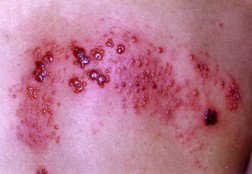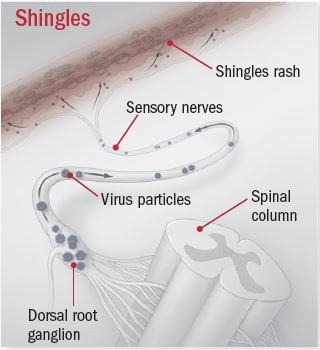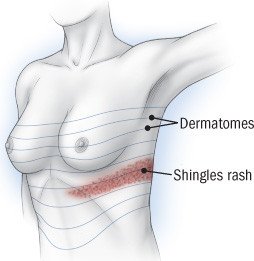Shingles (herpes zoster)
Medically reviewed by Drugs.com. Last updated on Jan 23, 2025.
What is Shingles (herpes zoster)?

Shingles, also known as herpes zoster or just zoster, occurs when a virus in nerve cells becomes active again later in life and causes a skin rash.
The virus that causes shingles, the varicella-zoster virus, is the same virus that causes chickenpox. It is a member of the herpes virus family. Once you have had chickenpox, varicella-zoster virus remains in your body's nerve tissues and never really goes away. It is inactive, but it can be reactivated later in life. This causes shingles.
|
|
Doctors aren't sure how or why the varicella-zoster virus reactivates, but they believe your immune system's response to the virus weakens over the years after childhood chickenpox. When the virus reactivates, it travels through nerves, often causing a burning or tingling sensation in the affected areas. Two or three days later, when the virus reaches the skin, blisters appear grouped along the affected nerve. The skin may be very sensitive, and you may feel a lot of pain.
|
Once activated, the shingles virus travels along a nerve to the skin, where it forms a rash. Shingles iIllustration by Scott Leighton. |
If you have had chickenpox, you are at risk of developing shingles. However, the virus doesn't reactivate in everyone who has had chickenpox. Shingles most often appears in people older than 50 and in people with weakened immune systems. If you are having treatment for cancer, for example, you are more likely to get shingles.
Your chances of getting shingles increase as you get older, although the disease can occur at any age. When shingles appears in children, which is uncommon, it usually is very mild. Up to 20% of people in the United States develop the disease at some point. However, the incidence of shingles will likely fall since most children have been vaccinated against chickenpox.
Potential complications of shingles include:
- Post-herpetic neuralgia — About 10% of adults who get shingles experience long-term pain in the area of skin where blisters occurred, even after the rash has healed completely. This condition may last for months or, rarely, years. Severe pain is most common in older patients and often is accompanied by extreme sensitivity to heat and cold in the affected area of skin.
- Herpes zoster ophthalmicus — This occurs when shingles involves the eye. Herpes zoster ophthalmicus can affect your vision, even causing blindness, and can be very painful.
- Otic zoster — Also called Ramsay Hunt syndrome or geniculate zoster, otic zoster occurs when shingles affects the ears. It can cause hearing loss.
- Bell's palsy — Shingles can cause Bell's palsy, in which a facial nerve is paralyzed.
Symptoms
Shingles usually begins with a burning sensation, a mild itching or tingling or a shooting pain in a specific area of skin. The affected area usually is located only on one side of the chest, abdomen, or face, or on a portion of an arm or leg. The skin may be extremely sensitive, so that you may not be able to stand clothing touching or rubbing the area.
After about five days, the skin becomes red and mildly swollen, and a rash appears. Blisters may cluster in patches or form a continuous line that roughly follows the path of the infected nerve. The blisters may be painful or itchy, and some may be as large as the palm of your hand. Blisters continue to appear over two to seven days and eventually break, form crusts and then heal.
Shingles also can cause fatigue, a low-grade fever and mild muscle aches.
Diagnosis
Shingles can be difficult to diagnose before visible signs of the disease appear. Once a rash and blisters appear, your doctor probably will diagnose shingles based on your symptoms and the appearance of your skin. Rarely, when the diagnosis is less certain, the doctor may scrape tissue, collect cells from the affected skin and examine them under a microscope for cellular changes consistent with a herpes zoster infection.
If you have a rash across the bridge of your nose or anywhere near your eyes, your doctor will include an ophthalmologist (eye doctor) in your care.
Expected duration
Shingles usually takes seven to 10 days to run its course, although blisters may take several weeks to disappear completely. Within four weeks, the appearance of your skin most likely will return to normal. Some people are left with dark spots on the skin in the area of the original rash.
The duration of pain is highly variable. Most people's pain decreases within two or three months. About 10% of people have pain for many months and about 2% continue to have pain longer than one year.
Prevention
The Centers for Disease Control and Prevention (CDC) recommends that healthy adults over age 50 get two doses of a vaccine called Shingrix. Doses are given two to six months apart. Shingrix is said to be more than 90% effective against shingles and postherpetic neuralgia — a painful nerve condition that can arise as a shingles complication. This newer vaccine is more effective than Zostavax, which had been used since 2006 and has been reported to reduce the risk of shingles by only 51%. Research has also shown that Zostavax loses its ability to prevent shingles after five years. Because Shingrix has proven to be much more effective against shingles, Zostavax is no longer produced.
The CDC says you should get vaccinated with Shingrix even if you aren't sure you've had chickenpox and if you've already had shingles. Although it's uncommon, you can get shingles more than once. In addition, you should get the Shingrix vaccine even if you already got the Zostavax vaccine — although you should wait at least eight weeks from the time you received Zostavax to get the Shingrix shot.
Most people who get Shingrix experience only mild side effects.
In theory, the standard chickenpox vaccine for children should prevent shingles later in life.
Drugs used to treat this and similar conditions
Valtrex
Valtrex is an antiviral drug used to treat infections caused by herpes viruses. Learn about side ...
Zovirax
Zovirax treats viral infections caused by genital herpes, cold sores, shingles, and chicken pox ...
Botox
Botox is used cosmetically to reduce facial lines and wrinkles and for medical purposes for ...
Prednisone
Prednisone is used to treat allergic disorders, ulcerative colitis, psoriasis and arthritis. Learn ...
Famciclovir
Famciclovir is used for cold sores, herpes simplex, mucocutaneous/immunocompetent host, herpes ...
Acyclovir
Acyclovir is an antiviral drug. It slows the growth and spread of the herpes virus. It will not ...
Valacyclovir
Valacyclovir is used to treat genital herpes, cold sores, shingles, and chicken pox. Learn about ...
Treatment
If your condition is diagnosed within 72 hours after the rash appears, your doctor may prescribe antiviral medication. Some antiviral medications used to treat shingles include acyclovir (Zovirax), famciclovir (Famvir) and valacyclovir (Valtrex). Antiviral medications may help to reduce the risk of developing chronic (long-lasting) pain from shingles.
The skin rash and blisters should be rinsed gently once or twice per day with cool water. Your doctor may suggest that you use antibiotic ointment on open areas. Because the pain that accompanies shingles can be intense, your doctor probably will prescribe a pain medication.
For post-herpetic neuralgia, different medications are often prescribed for the pain that lingers well after the rash has gone away. These drugs alter the way pain signals are perceived by our central nervous system. Examples include amitriptyline (Elavil, Endep), doxepin (Adapin, Sinequan) and gabapentin (Neurontin).
When shingles affects the eyes, an eye specialist (ophthalmologist) should be consulted immediately.
Treatment options
The following list of medications are related to or used in the treatment of this condition.
When to call a professional
Early treatment may help deter long-term complications, so call your doctor immediately if you are experiencing symptoms of shingles.
Prognosis
Most people recover completely from an acute episode with no pain; and skin color returns to normal. Once you have had shingles, it is unusual for the condition to return. Long-term complications from shingles, such as post-herpetic neuralgia, may continue for months or many years. The disease also may cause varying degrees of skin discoloration, primarily darkening.
Additional info
National Institute of Allergy and Infectious Diseases (NIAID)
https://www.niaid.nih.gov/
Centers for Disease Control and Prevention (CDC)
https://www.cdc.gov/
Further information
Always consult your healthcare provider to ensure the information displayed on this page applies to your personal circumstances.



